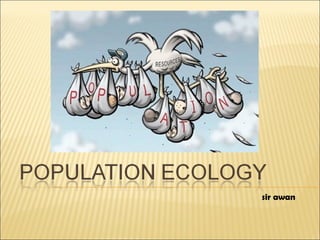
Grade 10 - Population Ecology
- 1. sir awan
- 2. Ecology - Study of interactions among organisms and their environment Conservation biology, environmentalism: preservation of natural world
- 3. • Biosphere • Bioma • Ecosystemas ECOSYSTEM LEVEL Eucalyptus forest • Community • Population • Individu • Organ system • Organ • Tissue • Cell • Molecular COMMUNITY LEVEL All organisms in eucalyptus forest POPULATION LEVEL Group of flying foxes ORGANISM LEVEL Flying fox ORGAN SYSTEM LEVEL Nervous system ORGAN LEVEL Brain Brain Nerve TISSUE LEVEL Nervous tissue CELLULAR LEVEL Nerve cell MOLECULAR LEVEL Molecule of DNA Spinal cord
- 4. Population: All the individuals of a species that live together in an area Demography: The statistical study of populations, allows predictions to be made about how a population will change
- 5. Three Key Features of Populations Size Density Dispersion
- 6. Three Key Features of Populations Size: number of individuals in an area
- 7. Three Key Features of Populations Growth Rate: Birth Rate (natality) - Death Rate (mortality) How many individuals are born vs. how many die Birth rate (b) − death rate (d) = rate of natural increase (r)
- 9. Three Key Features of Populations Density: measurement of population per unit area or unit volume Pop. Density = # of individuals ÷ unit of space
- 10. Immigration: movement of individuals into a population Emigration: movement of individuals out of a population Density -dependent factors: Biotic factors in the environment that have an increasing ef fect as population size increases (disease, competition, parasites) Density -independent factors: Abiotic factors in the environment that af fect populations regardless of their density (temperature, weather)
- 11. Factors That Affect Future Population Growth Immigration Natality + + Population Emigration - Mortality
- 13. Three Key Features of Populations Dispersion: describes the spacing of organisms relative to each other – Clumped - often correlates with resources – Uniform: interactions among individuals – Random: no pattern
- 14. Population density = number of individuals in a given area or volume Count all the individuals in a population Estimate by sampling Mark-Recapture Method
- 15. Idealized models describe two kinds of population growth: 1. Exponential Growth has no upper limit and populations grow very quickly 2. Logistic Growth has a limit and growth approches this limit in a sigmoidal fashion Logistic growth is more realistic in real life, but exponential growth is a better model for bacterial cultures, etc. that have unlimited resources and space
- 16. Carr ying Capacity (k): The maximum population size that can be supported by the available resources There can only be as many organisms as the environmental resources can support
- 17. • A J-shaped growth curve, described by the equation G = rN, is typical of exponential growth – G = the population growth rate – r = the intrinsic rate of increase, or growth rate in an ideal environment (births-deaths) – N = the population size
- 18. Figure 35.3A
- 19. – K = carrying capacity – The term (K - N)/K accounts for the leveling off of the curve
- 21. During the initial stage, during the lag phase, the rate of plant growth is slow. Rate of growth then increases rapidly during the exponential phase. After some time the growth rate slowly decreases due to limitation of nutrients. This phase constitutes the stationary phase.
- 22. Declining birth rate or increasing death rate are caused by several factors including: Limited food supply The buildup of toxic wastes Increased disease Predation
- 23. About every 10 years, both hare and lynx populations have a rapid increase (a "boom") followed by a sharp decline (a "bust")
- 24. r Selection (many offspring) Short life span Small body size Reproduce quickly Have many young Little parental care Ex: cockroaches, weeds, bacteria
- 25. • K Selection (few offspring) Long life span Large body size Reproduce slowly Have few young Provides parental care Ex: humans, elephants
- 26. Distribution of males and females in each age group of a population Used to predict future population growth
- 28. J curve growth Why doesn’t environmental resistance take effect? Altering their environment Technological advances The cultural revolution The agricultural revolution The industrial-medical revolution
- 29. Doubled three times in the last three centuries About 6,1 billion and may reach 9.3 billion by the year 2050 Improved health and technology have lowered death rates
- 31. What next?
Notas del editor
- Although several species may share a habitat they each have their own niche. A niche is a very narrow range where a species fits within a habitat.
- Although several species may share a habitat they each have their own niche. A niche is a very narrow range where a species fits within a habitat.
- Although several species may share a habitat they each have their own niche. A niche is a very narrow range where a species fits within a habitat.
- Although several species may share a habitat they each have their own niche. A niche is a very narrow range where a species fits within a habitat.
- Although several species may share a habitat they each have their own niche. A niche is a very narrow range where a species fits within a habitat.
- Although several species may share a habitat they each have their own niche. A niche is a very narrow range where a species fits within a habitat.
- Although several species may share a habitat they each have their own niche. A niche is a very narrow range where a species fits within a habitat.
- Carrying capacity can change, as environment changes. Food supply, predators: number and kinds, weather, seasons. Rabbits in australia ate all the food. Ditto for deer on Angel Island.